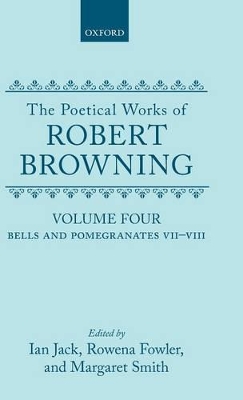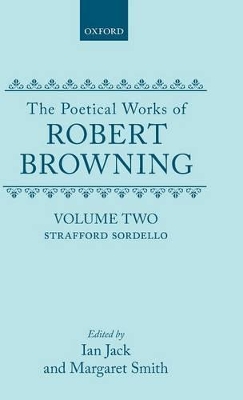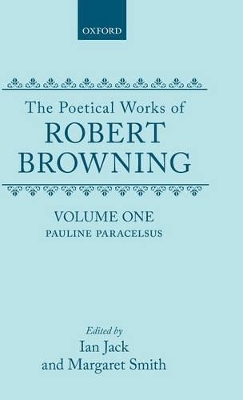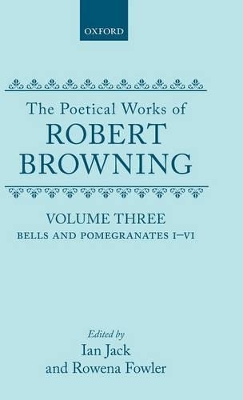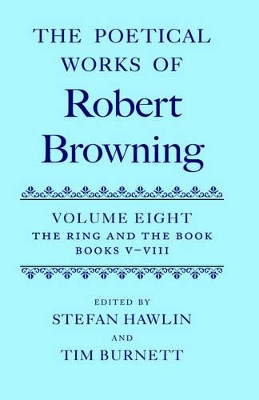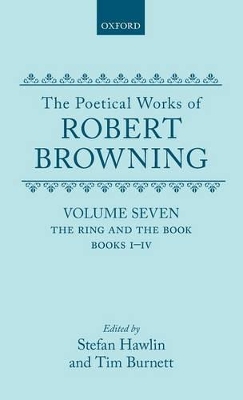Oxford English Texts: Browning
7 total works
`Browning really comes back to life in the marvellous third volume of the new Oxford Browning', wrote John Bayley, choosing it as one of his Books of the Year for 1988. While Volume III included six of the eight Bells and Pomegranates pamphlets, the present volume completes the series and includes the most remarkable of all, Dramatic Romances and Lyrics. Here we find `Pictor Ignotus', `The Lost Leader', `The Bishop orders his Tomb', `The Laboratory', `The Boy and the Angel', and the first part of `Saul'. Also included are Christmas-Eve and Easter-Day and the essay on Shelley.
As the Times Literary Supplement reviewer of the earlier volumes commented, `readers of a poet like this need all the help they can get; and Jack and Smith have provided it in abundance.' Each poem is fully annotated, and accompanied by a detailed introduction which provides information on the chronology of composition and on Browning's sources.
As the Times Literary Supplement reviewer of the earlier volumes commented, `readers of a poet like this need all the help they can get; and Jack and Smith have provided it in abundance.' Each poem is fully annotated, and accompanied by a detailed introduction which provides information on the chronology of composition and on Browning's sources.
The Poetical Works of Robert Browning: Volume II. Strafford, Sordello
by Robert Browning
Published 8 March 1984
Margaret Smith, winner of the Rose Mary Crawshay Prize for her work on the Brontës
The Poetical Works of Robert Browning: Volume I. Pauline, Paracelsus
by Robert Browning
Published 7 April 1983
Margaret Smith was the winner of the Rose Mary Crawshay Prize for her work on the Clarendon Edition of the Brontës work
The Poetical Works of Robert Browning: Volume V. Men and Women
by Robert Browning
Published 28 December 1995
This is the first full scholarly edition of Browning's greatest and perhaps best-known collection of short poems, Men and Women. A comprehensive introduction shows how new research by Ian Jack an Robert Inglesfield has unearthed material which throws fresh light on the composition and dates of such famous pieces as 'Fra Lippo Lippi', 'Childe Roland to the Dark Tower Came', and 'One Word More: To E.B.B.'.
This edition uses a critical text based on that of Browning's final collection, and has detailed introductions to the individual poems. It is the fifth volume in the highly praised Political Works of Robert Browning.
This edition uses a critical text based on that of Browning's final collection, and has detailed introductions to the individual poems. It is the fifth volume in the highly praised Political Works of Robert Browning.
The Poetical Works of Robert Browning: Volume III. Bells and Pomegranates I-VI
by Robert Browning
Published 2 June 1988
This volume contains six of the eight Bells and Pomegranates, modestly-priced pamphlets published by Edward Moxon in a bid to help Browning recover from the ridicule which greeted the first appearance of Sordello. It includes Pippa Passes, four other dramatic works, and Dramatic Lyrics, the first of the great collections of short poems with which Browning established his reputation. In addition, a version of a poem on the Pied Piper by Browning's father is here
printed for the first time. All significant textual variants are recorded, and each of the Bells is accompanied by an introduction and by full annotation. New information throws further light on this most important period in Browning's poetic career.
printed for the first time. All significant textual variants are recorded, and each of the Bells is accompanied by an introduction and by full annotation. New information throws further light on this most important period in Browning's poetic career.
The Poetical Works of Robert Browning: Volume VIII. The Ring and the Book, Books V-VIII
by Robert Browning
Published 15 February 2001
In old age, Browning always referred people to The Ring and the Book as his finest achievement. This is the second of the three volumes of the Oxford edition presenting this great Italian murder-story, including the monologues of the villain, the aristocrat Guido Franceschini, Pompilia his abused wife, and Caponsacchi, the priest who tries to rescue her from death. The commentary, at the bottom of each page, elucidates Browning's creative and sometimes
challenging use of language with reference to his correspondence, his historical sources, and his own rich experience of Italy. Previously unidentified allusions are fully explained, and a newly discovered source from a seventeenth-century Italian chronicle is presented for the first time (in Appendix B), allowing
further insight into Browning's engagement with history. The copy text of 1888-9 has numerous emendations to its punctuation, both those authorized by the poet in the last year of his life and those resulting from corrected compositors' errors, and these, combined with fourteen emendations to substantives, produce a text as near as possible to Browning's final intentions.
challenging use of language with reference to his correspondence, his historical sources, and his own rich experience of Italy. Previously unidentified allusions are fully explained, and a newly discovered source from a seventeenth-century Italian chronicle is presented for the first time (in Appendix B), allowing
further insight into Browning's engagement with history. The copy text of 1888-9 has numerous emendations to its punctuation, both those authorized by the poet in the last year of his life and those resulting from corrected compositors' errors, and these, combined with fourteen emendations to substantives, produce a text as near as possible to Browning's final intentions.
The Poetical Works of Robert Browning: Volume VII. The Ring and the Book, Books I-IV
by Robert Browning
Published 25 June 1998
Henry James described Browning's extended dramatic poem The Ring and the Book, over 20,000 lines in length, as `a great living thing', `a proportioned monstrous magnificence'. The story was developed from some old legal documents discovered by Browning concerning an actual murder which took place in Rome in 1698, and its writing was his major preoccupation in the 1860s, the early years of his widowerhood in London. This volume gives us the first third of the
poems, Books I to IV. The Introduction draws on unpublished letters, journals, and working papers not examined by previous editors, to illuminate how the poem was conceived and researched, the range of people the poet consulted, and the five-year period of composition. The poem's complex publishing history
is disentangled in the Text part of the Introduction, including a discussion of the corrections and revisions Browning made on sheets from volumes I, III, and IV of the second edition, which he later forgot and which never appeared in print. Appendix E gives these important variants in full. The annotation presents new contextual matter, including unpublished letters relating to `Lyric Love', Browning's famous invocation to his dead wife. The appendices give the original Italian text of
Browning's second source, `Morte dell'Uxoricida Guido Franceschini Decapitato'; two previously unpublished autograph chronologies in which the poet worked out historical details of his story; and a new account of the biographical significance of the `Ring' image.
The editors have made six substantive emendations to the text, ranging from inaccuracies in the original typesetting to changes made by Browning after publication. The evolution of the text from manuscript to copy text is also discussed, and an appendix is devoted to a set of corrected proofs preserved at Yale, a textual evolutionary dead end of great interest and significance.
poems, Books I to IV. The Introduction draws on unpublished letters, journals, and working papers not examined by previous editors, to illuminate how the poem was conceived and researched, the range of people the poet consulted, and the five-year period of composition. The poem's complex publishing history
is disentangled in the Text part of the Introduction, including a discussion of the corrections and revisions Browning made on sheets from volumes I, III, and IV of the second edition, which he later forgot and which never appeared in print. Appendix E gives these important variants in full. The annotation presents new contextual matter, including unpublished letters relating to `Lyric Love', Browning's famous invocation to his dead wife. The appendices give the original Italian text of
Browning's second source, `Morte dell'Uxoricida Guido Franceschini Decapitato'; two previously unpublished autograph chronologies in which the poet worked out historical details of his story; and a new account of the biographical significance of the `Ring' image.
The editors have made six substantive emendations to the text, ranging from inaccuracies in the original typesetting to changes made by Browning after publication. The evolution of the text from manuscript to copy text is also discussed, and an appendix is devoted to a set of corrected proofs preserved at Yale, a textual evolutionary dead end of great interest and significance.
